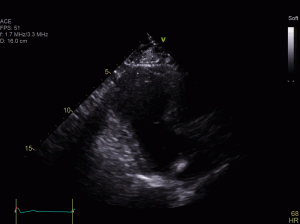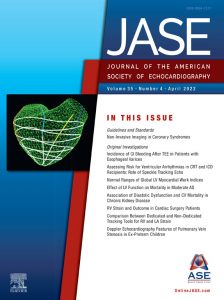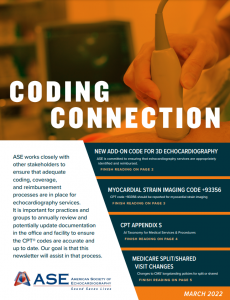 The CASE Editorial team is excited to announce the latest addition to the CASE homepage, Sonographer Sound-Off. This new interactive element provides an opportunity for sonographers to share tips and tricks they have learned in everyday practice. Congratulations to Agatha Kwon, BSc (Hon), GradDipCardiacUltrasound, The Royal Brisbane and Women’s Hospital, Queensland, Australia, for supplying the images and text for the INAUGURAL Sonographer Sound-Off. Learn more here.
The CASE Editorial team is excited to announce the latest addition to the CASE homepage, Sonographer Sound-Off. This new interactive element provides an opportunity for sonographers to share tips and tricks they have learned in everyday practice. Congratulations to Agatha Kwon, BSc (Hon), GradDipCardiacUltrasound, The Royal Brisbane and Women’s Hospital, Queensland, Australia, for supplying the images and text for the INAUGURAL Sonographer Sound-Off. Learn more here.
NEW CASE Sonographer Feature!
New Multi-Society Recommendations Highlight How Non-Invasive Imaging Modalities Play a Key Role in the Evaluation and Management of Patients with Coronary Artery Disease
Coronary artery disease (CAD) is one of the major causes of mortality and morbidity worldwide. Noninvasive imaging modalities play a fundamental role in the evaluation
and management of patients with known or suspected CAD. A new, multi-society document,
Non-Invasive Imaging in Coronary Syndromes: Recommendations of The European Association of Cardiovascular Imaging and the American Society of Echocardiography, in Collaboration with The American Society of Nuclear Cardiology, Society of Cardiovascular Computed Tomography, and Society for Cardiovascular Magnetic Resonance, focuses on how multiple imaging techniques can evaluate different aspects of CAD and the importance of choosing the proper imaging test depending on the patient characteristics, clinical scenario, and expertise at each imaging center. This document, which was developed by the European Association of Cardiovascular Imaging (EACVI) and the American Society of Echocardiography (ASE), in collaboration with the American Society of Nuclear Cardiology (ASNC), the Society of Cardiovascular Computed Tomography (SCCT), and the Society for Cardiovascular Magnetic Resonance (SCMR), is published in the April 2022 issue of the Journal of the American Society of Echocardiography. Read more here.
ASE Statement on a Patient-Centered and Personalized Approach to Imaging
4-11-2022 – ASE approves the following policy:
ASE Statement on a Patient-Centered and Personalized Approach to Imaging
ASE strongly endorses patient-centered and personalized imaging. Rather than an automatic testing default, a personalized approach to testing based on clinical information is better and benefits the patient. Every clinical presentation should be evaluated individually to determine which imaging test is appropriate. Factoring in technical local expertise, quality and availability of equipment, likelihood of cardiovascular disease, and patient preference are all extremely important in deciding the optimal approach. We believe a multi-disciplinary team is best and the patient, patient advocate and their family’s viewpoints are important contributors for shared decision-making. A patient-centered approach may reduce administrative burden, avoid care delays, and support the unique role of the physician/patient interaction. In alignment with personalized imaging, ASE also believes in high-quality testing. The ASE Accreditation Policy Statement published on February 15, 2014, outlines ASE’s commitment to advocating for an environment of excellence in quality and practice of cardiovascular ultrasound.
Speckle-Tracking Attributes in the April JASE
 The April JASE includes, “Burden of Ventricular Arrhythmias in Cardiac Resynchronization Therapy Defibrillation and Implantable Cardioverter-Defibrillator Recipients with Recovered Left Ventricular Ejection Fraction: The Additive Role of Speckle-Tracking Echocardiography,” by Erberto Carluccio, MD, et al. Dr. Carluccio said, “Predicting the occurrence of life-threatening ventricular arrhythmias in patients with heart failure with reduced ejection fraction remains a challenge. LVEF<35% currently represents the guideline-recommended parameter to select candidates for ICD therapy but it has a low sensitivity in predicting sudden cardiac death. In this study we showed that among CRT-D and ICD candidates, the risk for ventricular arrhythmias requiring appropriate shock progressively decreased with improvement in ejection fraction. However, in patients whose follow-up EF improved to >35%, the risk for ventricular arrhythmias, although markedly decreased, remained high in the presence of persistently high values of mechanical dispersion (the SD of time–to–peak strain curves in apical longitudinal views).” This clinical investigation is complemented by an editorial from Gilson C. Fernandes, MD, and Jagmeet P. Singh, MD. Other clinical investigations in this issue explore normal values for global left ventricular myocardial work, adverse outcomes in moderate aortic stenosis, gastrointestinal bleeding risk after transesophageal echocardiography in patients with esophageal varices, echocardiographic parameters associated with cardiovascular mortality in chronic kidney disease, studies of right ventricular and left atrial strain, Doppler echocardiographic features of pulmonary vein stenosis in ex-preterm children, and sex-, age-, and race-related normal values of right ventricular diastolic function parameters from the World Alliance Societies of Echocardiography.
The April JASE includes, “Burden of Ventricular Arrhythmias in Cardiac Resynchronization Therapy Defibrillation and Implantable Cardioverter-Defibrillator Recipients with Recovered Left Ventricular Ejection Fraction: The Additive Role of Speckle-Tracking Echocardiography,” by Erberto Carluccio, MD, et al. Dr. Carluccio said, “Predicting the occurrence of life-threatening ventricular arrhythmias in patients with heart failure with reduced ejection fraction remains a challenge. LVEF<35% currently represents the guideline-recommended parameter to select candidates for ICD therapy but it has a low sensitivity in predicting sudden cardiac death. In this study we showed that among CRT-D and ICD candidates, the risk for ventricular arrhythmias requiring appropriate shock progressively decreased with improvement in ejection fraction. However, in patients whose follow-up EF improved to >35%, the risk for ventricular arrhythmias, although markedly decreased, remained high in the presence of persistently high values of mechanical dispersion (the SD of time–to–peak strain curves in apical longitudinal views).” This clinical investigation is complemented by an editorial from Gilson C. Fernandes, MD, and Jagmeet P. Singh, MD. Other clinical investigations in this issue explore normal values for global left ventricular myocardial work, adverse outcomes in moderate aortic stenosis, gastrointestinal bleeding risk after transesophageal echocardiography in patients with esophageal varices, echocardiographic parameters associated with cardiovascular mortality in chronic kidney disease, studies of right ventricular and left atrial strain, Doppler echocardiographic features of pulmonary vein stenosis in ex-preterm children, and sex-, age-, and race-related normal values of right ventricular diastolic function parameters from the World Alliance Societies of Echocardiography.
A new guideline written in collaboration with several societies, “Non-invasive Imaging in Coronary Syndromes: Recommendations of The European Association of Cardiovascular Imaging and the American Society of Echocardiography in Collaboration with the American Society of Nuclear Cardiology, Society of Cardiovascular Computed Tomography, and Society for Cardiovascular Magnetic Resonance,” is the April CME article.
A correction is also published in this issue for “Recommended Standards for the Performance of Transesophageal Echocardiographic Screening for Structural Heart Intervention,” by Hahn et al. which appeared in the January 2022 JASE. Several letters to the editor offer robust discussion.
The President’s Message from Raymond Stainback, MD, FASE, explores CASE, which in May goes monthly. The CASE Editor-in-Chief, Vincent L. Sorrell, MD, FASE, is a co-author. The continuing education and meeting calendar outlines a multitude of learning options near and far.
March GEM – Gregory Tatum, MD, FASE

During the month of March, Gregory Tatum, MD, FASE, was recognized for Going the Extra Mile and received a GEM award!
His nominator, Piers Barker, MD, FASE, on behalf of ASE’s Pediatric and Congenital Heart Council, said, “From the PCHD Council, in recognition of exceptional service to its members and the entire ASE community, Dr. Tatum is being honored for his exemplary dedication in leading an outstanding webinar series. Our patients, families, and echo labs all benefit from his work.”
Do you know an ASE member who’s gone the extra mile? Join us in celebrating ASE members who are making the world a better place, be it for their dedication to the field of cardiovascular ultrasound, being an outstanding mentor to students or fellows, their commitment to quality patient care, a milestone service anniversary, or congratulating them on a major accomplishment. Learn how to nominate someone here.
ASE is Here to Help with Your Coding Questions
 ASE is committed to providing our members with the tools and resources needed to ensure they are coding accurately, maintaining compliance with all requirements, and maximizing appropriate reimbursements.
ASE is committed to providing our members with the tools and resources needed to ensure they are coding accurately, maintaining compliance with all requirements, and maximizing appropriate reimbursements.
The 2022 Coding Connection is now available and free to members. This resource will assist you in coding accurately for the services you provide, especially in today’s environment of declining reimbursement and increased scrutiny. This document includes important information on the new add-on code for 3D echocardiography, the myocardial strain imaging code +93356, CPT Appendix S, Medicare split/shared visit changes, and more.
ASE also retains a coding expert who can answer your specific questions. You may link to this service on-demand, directly through the ASE member portal. Log in to your Member Portal and click “Ask a Coding Expert” to get an answer from the experts!
Give ASEF Your Best Shot!
 The ASE Foundation is accepting photography submissions for the 2022 photo exhibit titled, Hearts All Around Us. The theme of this year’s exhibit is heart-shaped things you have come across in nature, architecture, everyday life, etc. Since you work with the heart, you probably find yourself seeing hearts all around. If you have a picture that resembles a heart shape, we want it! Full submission details can be found online here.
The ASE Foundation is accepting photography submissions for the 2022 photo exhibit titled, Hearts All Around Us. The theme of this year’s exhibit is heart-shaped things you have come across in nature, architecture, everyday life, etc. Since you work with the heart, you probably find yourself seeing hearts all around. If you have a picture that resembles a heart shape, we want it! Full submission details can be found online here.
Photos will be accepted through April 15.
Image features Heart Rock on the Road to Hana in Maui, Hawaii.
Credit: Angie Porter, ASE Senior Director of Marketing & Communications
Spring Giving Month
Join ASE members celebrating Women’s History Month with the ASE Foundation by donating today. Think of your mentors, supervisors, family members – any women who are important to you and donate in their honor. The honored women will be featured on our website.
When you donate, include a tribute message and send a picture of the honoree to Mary Carmody, ASE Foundation Manager. Help the Foundation bloom into Spring, and let us shine a spotlight on the women who have inspired you!
Upcoming Courses from ASE
Don’t miss these three upcoming educational courses from ASE. Remember to log in to your ASE member portal for member discounts.
Advanced Echo: Virtual Experience
Content Available March 21, 2022
This online course will present the latest information on established and emerging cardiovascular ultrasound technologies. Combining the course highlights of Echo Hawaii and State-of-the-Art Echocardiography, expert faculty will discuss state-of-the-art technologies with a particular focus on how they can be effectively applied in the clinical setting. Case-based approaches are used to discuss new and established applications of echocardiography for diagnosis and guiding management in patients with a broad array of cardiovascular conditions. This content will be available beginning March 21, 2022 and will include 12 CME/MOC credits.
23rd Annual ASCeXAM/ReASCE Review Course: Virtual Experience
Content Available May 9, 2022
This course is specifically designed to help you gain the knowledge you need to pass the ASCeXAM and ReASCE exams. Even if you are not taking the exam this year, this course offers comprehensive cardiovascular ultrasound education that includes 28.75 AMA PRA Category 1 Credits™. Registration includes pre-recorded presentations, access to the PDF slides, and unlimited, on-demand access to the content through August 7, 2022.
This virtual review course also includes a live component with two, two-hour Q&A sessions hosted by expert faculty on Saturday, July 9, 2022.
33rd Annual Scientific Sessions
June 10-13, 2022 | HYBRID Event
ASE 2022 will be live and back in person in June 2022! Plan now to join us in Seattle, Washington, at the Seattle Convention Center, June 10 – 13, 2022.
Here’s a quick breakdown by the numbers:
- 59 Live Sessions
- 53 On-Demand Sessions
- 9 Chalk Talks
- 7 Do-It-Yourself Acquisition Sessions
- 6 Learning Labs
- 6 Networking Events
- 2 Moderated Poster Sessions
- 2 Receptions
- 1 Workshop
Download the ASE 2022 Advance Program for all the details, and register today. Registration is available in two options, ASE 2022 In-Person and ASE 2022 Virtual.
